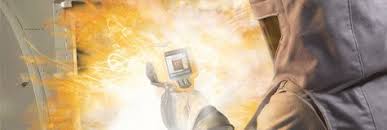
More than 77% of all electrical injuries are caused by arc flash incidents.
The result of an arc fault is usually a massive explosion; arc blast is the pressure wave which is also present when light and heat are emitted during the explosion. The arc flash releases hot gases and radiant energy which is four times higher than the surface of the sun`s temperature. This high temperature can set fire to clothing and severely burn human skin and damage the human body. Moreover, it can easily melt or even vaporise some metals, such as copper.
Throughout the vicinity of the explosion, solid metal debris can also cause severe damages.
Besides the physical injuries, arc flash explosion can also inflict serious psychological symptoms such as depression or anxiety.
What is Arc Flash?
An arc flash happens when electric current flows through an air gap between conductors. This can happen when the electrical conductors are too close to each other and significant fault currents flow through them. In these circumstances, ionization of the air can take place and creates a low resistance path and it allows to current the flow through the air.
It is thought that low voltage is safe from arc flash, but the reality is that the hazard level is even higher in these cases, due to the high fault currents.
What are the most common causes of Arc Flash?
• Carelessness or lack of electrical safety awareness/ training
• Using improper tools
• Worn, broken or improper insulation
• Insulation damage or damaged, faulty electrical equipment
• Improper preventative maintenance
• Exposure of electrical equipment to water or other liquids
• Exposed live part
• Static electricity
How to avoid Arc Flash
Most industries have a level of risk, but there are those that carry a higher risk such as utilities, energy companies, manufacturing companies or any large commercial, educational or leisure facilities.
Employers must protect their workers from the hazardous or even deadly effect of arc flash through careful training, preparation and providing PPE for their employees.
Health and safety legislation imposes a number of duties on employers and contractors in general when they work with electricity. IEEE 1584 standard is a guide for performing Arc Flash Hazard Calculations. This method is accepted industry practice to calculate the potential incident energy and conclude the PPE requirements.
Electrical Safety Equipment
PASS supply tools and specialised PPE for those who work in or around electricity. See our range of:
High Voltage Detection & Measurement
HV Training Courses
The PASS High Voltage Training Centre runs a number of courses with City & Guilds and Maritime & Guard Agency :
HV Authorised Person (SAP) / Switching Courses
City & Guilds High Voltage Accreditation
Marine & Offshore High Voltage Courses
Please if you have any further question do not hesitate to call our experts on 01642 931 329 or send an email to info@tester.co.uk.



